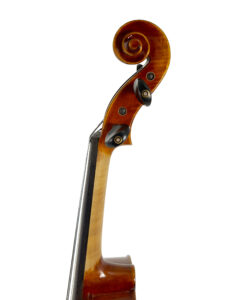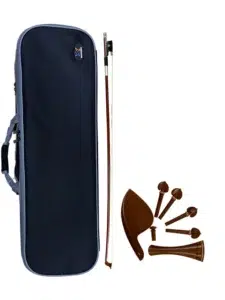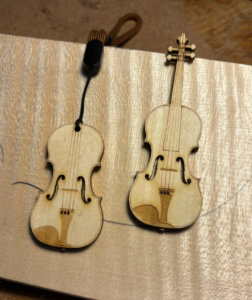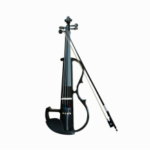Intermediate violins mark the learner’s progression from beginner to professional player and have a price range of $1000-$3000. In this article, we explore the definition of an intermediate violin, its features, and the buying and upgrading of it.
What is an intermediate violin?
An intermediate violin reflects a violinist’s ability to improve when learning the violin. It is essential for the transition stage of ability across levels. Compared to an entry-level violin, an intermediate violin has higher quality, better looks, and better tonal colours. Not only is there a noticeable change in tonal qualities, but the details are also more finely crafted.
The positioning of the intermediate violin provides learners with a better playing experience. It creates a better environment for them to improve their skills. This is an important milestone in the learner’s gradual journey into music. The richer, warmer resonance one can feel in the tonal colours of an intermediate violin inspires learners to show more emotion and expression in their music-making and playing.
Wood Selection:
In making a medium violin, the selection of wood directly affects the tonal colours, resonance and musical expression of the violin. Quality wood provides better sound characteristics and adds a unique character to the violin. The following are common wood choices for medium violin making:
- Top Plate Wood: Spruce wood is usually used as the main material for the top plate. Spruce wood is light, uniform, and has excellent vibrational conductivity, giving it a heavy, resonant tone that is suitable for emotionally rich music.
- Back plate and rib material: Maple is usually used for the back plate and ribs. It is tough and lightweight, giving the violin clear tonal colours. Maple also has a nice grain, giving the violin a better appearance.
- pegs and bridges: Good medium violins usually use hard materials such as beech wood for pegs and bridges. 5.
- Workmanship details: In addition to the choice of wood, the workmanship details of a medium violin are also a key factor in its tonal colours and quality. The luthier’s hand in carving the body, adjusting the bridge and string slots, and tuning the instrument requires a delicate and meticulous hand. These details determine the instrument’s resonance characteristics, acoustics, and playing comfort. When purchasing an intermediate violin, focus on the workmanship of the details of the violin.
The choice of wood for an intermediate violin is one of the keys to shaping the essence of its tonal colours. Quality wood gives the violin a unique sound character. It enhances the fullness and expressiveness of the tonal colours over time.
Tonal Colors:
The medium violin has a richer, warmer tone than entry-level instruments. It can produce more expression and emotion in a wider range of tones.
Why replace an intermediate violin?
For violin learners, moving from the beginner stage to the intermediate level means taking an important step in their musical journey. Replacing an intermediate violin is a decision to go deeper into violin playing, and here are some of the reasons why replacing an intermediate violin is a good idea at the right time:
- Tonal Colors: As violin playing skills improve, beginner violinists become sensitive to subtle changes in tone colour. An intermediate violin usually has richer, fuller tone colours, which allows it to better express the emotion and details of the music.
- Greater expressiveness: The intermediate violin has better acoustics and resonance, which allows the learner to feel and express emotion and expressiveness in his or her playing, thus creating a more personalized musical performance.
- Improvement of playing ability: A better violin requires more skill and control and is an opportunity for beginners to refine their playing. Playing more challenging pieces of music will help to develop different playing skills and musical understanding.
- Self-motivation: A better violin will motivate the learner to invest more time and effort in practice. This commitment improves one’s playing skills and fosters a deeper understanding and love of music.
- Achievement of musical goals: As learners progress, they may have higher musical goals, such as competing in music competitions or performing solo works. A better violin will give them a better chance of achieving these goals.
such as competing in music competitions or performing solo works. A better violin will give them a better chance of achieving these goals.
When considering a replacement intermediate violin, carefully weigh your needs and budget. The choice of instrument depends not only on price and tonal qualities but also on a combination of personal musical goals, styles, and preferences. Whenever a medium violin is replaced, it represents the learner’s strong determination and desire to excel as they move on to greater musical heights.
Transitioning from Beginner to Intermediate
As learners transition from beginner to intermediate, their playing skills improve dramatically. At this point, they will need a higher-quality violin to meet the higher music demands.
Replacing and upgrading your violin
Upgrading to an intermediate violin can produce greater tonal colours, resonance, and expressiveness. As their skills progress, intermediate learners need an instrument more suited to their development to express their musical intentions better.
How much does it cost to buy an intermediate violin?
Price Range Budget Considerations
The price of an intermediate violin varies between $1000-$3000. This price range is usually within an acceptable range while still providing better tonal qualities and a playing feel.
Modern violin makers usually make intermediate violins. Some luthiers may use machines at different stages of production, but the final assembly process must be handcrafted. These violins are typically made from tonewoods that have been stored for at least 10 years. Their top plates are usually solid spruce, and the back plates, ribs and necks are made of maple with a slight flap. Luthiers apply varnish by hand to give the violin a more refined appearance.
Intermediate violins have better tonal qualities and can be played with more layers and variations of tone colours. They are a great choice for students who want to explore their musical expression further.
Is it necessary for a beginner to buy an expensive violin?
When buying a violin, beginners are often faced with a key question: is it necessary to buy an expensive violin? This is a question that deserves deeper consideration, as beginners usually have limited needs and budgets. Here are some ideas on the subject.
Beginner stage: The beginner stage focuses on playing the fundamentals, including proper bowing, finger placement, note in tune, etc. The violin’s price is not the most important at this stage. An entry-level violin suitable for beginners can fully meet the basic practice and learning needs.
Musical development: At this early stage, the beginner may need clarification on his or her musical interests and direction. It may not be practical to purchase a too-expensive violin, as musical interests may change over time.
Music education: Beginners should invest more of their budget in music education, such as finding a good violin teacher and purchasing appropriate teaching materials. These factors are crucial in developing good playing skills and musical understanding.
Economic realities: Budget is an important consideration. For many beginners and families, purchasing an expensive violin may not be practical.
Beginners usually do not need to purchase an expensive violin and can consider upgrading to a more advanced instrument as their musical interests mature. It is helpful to consult with a professional violin teacher during the purchasing process to understand the right options for you. An expensive violin may be more than necessary. Still, if a beginner has a good budget and is determined to pursue a higher level of music, a better violin can help them progress more quickly.
What stage of violin learning should I buy an intermediate violin?
Before choosing to upgrade to an intermediate violin, a student should have mastered the basic skills of the violin, including proper holding position, basic bowing and left-hand technique. These skills are essential to realizing the full potential of the intermediate violin. As students begin to pursue higher demands in musical expression, litre to intermediate violin would be a good choice. Intermediate violins typically have richer, more expressive tonal colours, allowing students to convey emotion and musicality better.
Suppose a student has decided to pursue violin playing as a long-term interest and career development. In that case, purchasing an intermediate violin is a forward-thinking investment. If the student has plans to participate in competitions, performances, or further musical studies, upgrading to an intermediate violin may help them do better in those areas.
How do you choose a great intermediate violin?
Choosing a great intermediate violin requires consideration of several factors, including the quality of the wood, well-built workmanship, tonal qualities, and personal preference. The best way to get professional advice is by contacting a professional, depending on your needs and budget.
Summary
An intermediate violin is an important part of the violin learning process for violin learners, representing a higher musical dream and progress for the learner. The choice of an intermediate violin requires a combination of price, tonal qualities, workmanship and personal development needs. It is a good decision whether you are transitioning from a beginner to an intermediate level or upgrading to an intermediate violin for better expression of musical emotion. Weighing the advice of a professional violin teacher and personal preferences in your choice will help you find a great intermediate violin to accompany you on your musical journey.






